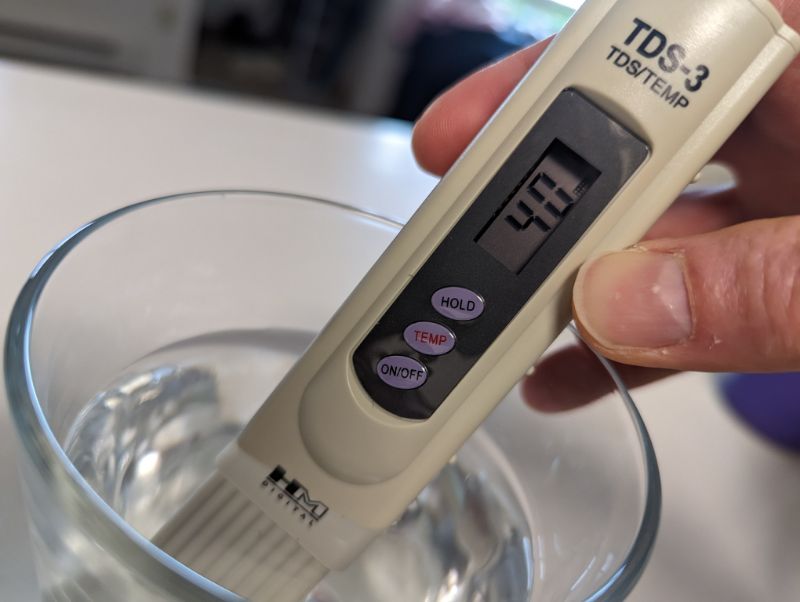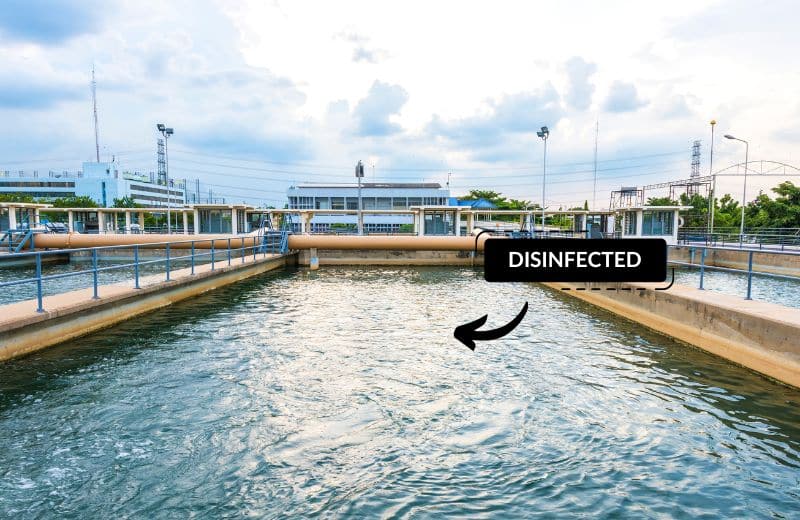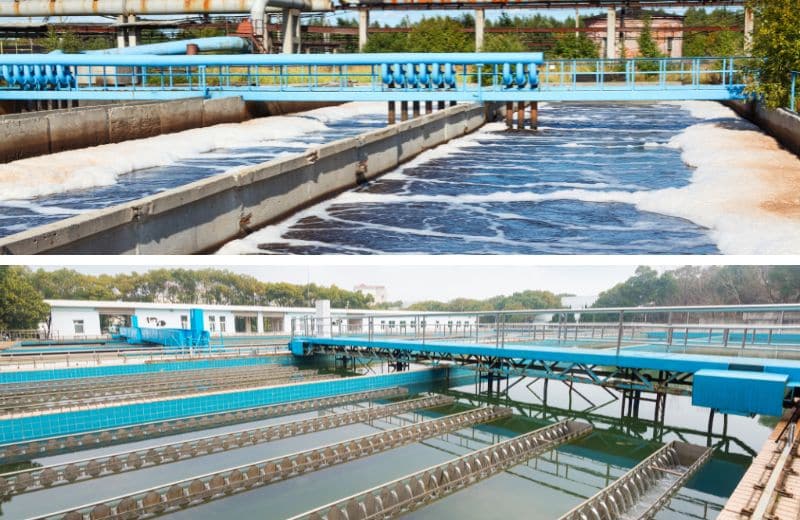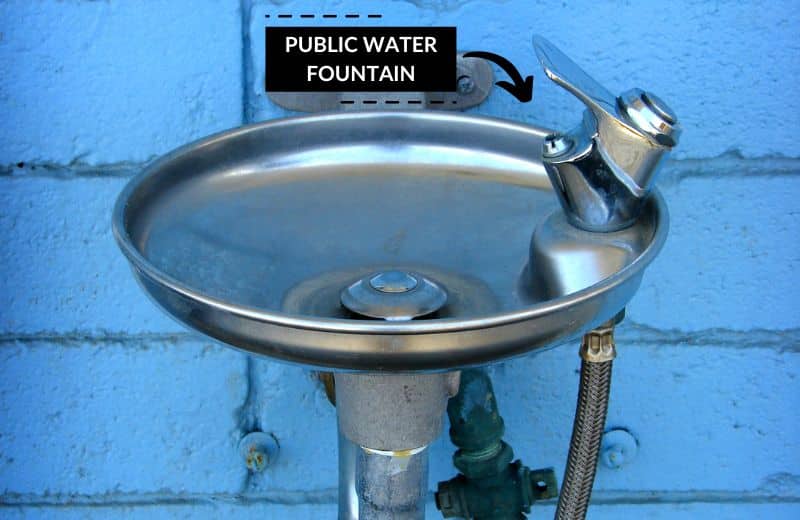How safe is the tap water in Fairbanks, Alaska? Are there any water contaminants that you should know about, and how does the water quality compare to that of other states and cities? Does the Fairbanks water exceed or violate EPA guidelines?
You’ll find all the answers to these questions and more in this Fairbanks water quality & safety guide.
📌 Key Takeaways:
- The drinking water in Fairbanks, Alaska is considered generally safe to drink.
- The Environmental Protection Agency (EPA) sets standards for tap water safety that all water utilities, including Fairbanks, must comply with.
- The 4 biggest problem contaminants in Fairbanks tap water are disinfection byproducts, chromium-6, PFOA, and radium – but these contaminants don’t exceed the EPA’s Maximum Contaminant Levels.
Table of Contents
- 🚰 Can You Drink Fairbanks Tap Water?
- 🗺️ Where Does the Tap Water in Fairbanks Come From?
- 📉 Who Regulates Fairbanks Drinking Water?
- 🧪 Fairbanks Annual Water Quality Report
- ☣️ Contaminants Found Above Guidelines in Tap Water in Fairbanks
- 🧫 Main Contaminants Found in Fairbanks Tap Water
- ⛲ Fairbanks Drinking Water in Public Places
- 💬 Frequently Asked Questions
🚰 Can You Drink Fairbanks Tap Water?
Yes, you can drink the water in Fairbanks, Alaska. The water doesn’t violate the Safe Drinking Water Act (SDWA) and is regulated for safety by the Environmental Protection Agency – which technically makes the water safe to drink.
The most recent of Fairbanks’ annual Consumer Confidence Reports shows that no contaminants are present in quantities exceeding the EPA’s Maximum Contaminant Levels (MCLs), meaning that you shouldn’t experience health effects from drinking the City’s water.
However, Fairbanks tap water isn’t perfect quality, clean, or pure. There are still some contaminants present – even if they’re detected below the EPA’s maximum allowances.
The Environmental Working Group is an independent organization that contests the EPA’s guidelines, arguing that they’re too lenient. The EWG has conducted its own research and produced a Tap Water Database for most Cities, including Fairbanks. In this database, 10 contaminants were noted to exceed the EWG’s Health Guidelines.
So, the drinking water distributed by the Fairbanks water service is safe according to EPA standards, but the EWG believes otherwise. We’ve looked more closely at these 10 contaminants later.
There’s also a low risk of lead contamination in Alaska. Lead is a highly toxic heavy metal with known health effects, including cancer. The most common way for lead to enter a municipal water supply is through old underground water pipes that were installed before lead became an illegal material to use in service lines. The danger of this type of lead contamination is that 0 PPM of lead might be detected at the water utility, but once water reaches your home, it might have absorbed dangerous levels of lead from its journey through the pipes.

There are several regional programs in place that should reduce your likelihood of lead exposure in Fairbanks, including the Regional Health Corporation Remote Maintenance Worker Programs and Alaska Village Safe Water Program. However, there’s still a risk that lead might leach into your water from your own plumbing if you have an old home built before 1986.
You can test your water for lead and fill out a survey to help the local water utility to determine where customer-owned lead service lines exist.
👨🔧 Looking for further reading? Our guide looks in detail at which 10 states have the worst-quality tap water.
Fairbanks SDWA Violations Within 10 Years
| Period of Compliance | Resolved? | Health-Based? | Category Code | Code | Rule Code | Contaminant Code | Rule Group Code | Rule Family Code |
|---|---|---|---|---|---|---|---|---|
| 07/01/2013 | Yes | Yes | Treatment Technique Violation (TT) | Failure To Address Deficiency (45) | Ground Water Rule (140) | Groundwater Rule (0700) | Microbials (100) | Groundwater Rule (140) |
Data Source: EPA ECHO database
🗺️ Where Does the Tap Water in Fairbanks Come From?
The majority of Fairbanks tap water comes from three wells beneath the City. These wells tap into a very large aquifer located beneath Tanana Vally and are between 70 to 90 feet deep. The City established its groundwater supply and distribution system in 1953.
The groundwater occurs in varying conditions depending on its exact location. Under the ground of the Tanana valley and under the higher slopes and ridges, groundwater occurs under water-table conditions. On the lower slopes, the water exists in artesian conditions.
Groundwater is generally higher-quality than surface water (such as rivers and reservoirs) because water is naturally filtered as it seeps through the layers of rock and earth into the aquifer. However, there are certain contaminants that specifically affect the quality of groundwater, including iron, manganese, and water hardness. Most groundwater in Fairbanks is naturally high in iron, but some groundwater supplies are iron-free.
Like all community water systems adhering to the EPA’s guidelines, the Fairbanks water service conducts hundreds of water tests per year (including testing at the source and post-treatment testing) as part of an ongoing assessment of water quality. If you want to keep informed and monitor the regular test results released in Fairbanks, you can use Alaska’s Drinking Water Watch webpage, which lets you search for test results (including an option to search for specific parameters) from an independent laboratory.
Water is then pumped to the Golden Heart Utilities Water Treatment Plant, where it undergoes several treatment processes, including mechanical filtration to remove particles, and (if necessary) UV treatment or chlorination to kill bacteria and other microorganisms.
The treated drinking water is stored in large reservoirs or water pressure tanks, ensuring that customers in Fairbanks have access to a reliable and constant supply of water even during times of peak demand.
Pressurized water is delivered via main water networks, which run under the City’s sidewalks and streets. Property owners are connected to the public watermains through their own private service lines.

📉 Who Regulates Fairbanks Drinking Water?
The City of Fairbanks tap water is managed by the Golden Heart Utilities Water Treatment Plant and is regulated by the Environmental Protection Agency, the Division of Environmental Health Drinking Water Program, and the Alaska Department of Environmental Conservation Division of Water.
All public water utilities must comply with the EPA’s National Primary Drinking Water Regulations, regulated drinking water contaminants that are considered (based on studies and research) to be harmful to human health.
According to these Regulations, water utilities – including Fairbanks, Alaska – must reduce contaminants to below the EPA’s maximum allowance – and provide water monitoring and testing as proof.
The EPA also has several Health Advisories for emerging contaminants that aren’t yet officially regulated. Water utilities aren’t legally required to reduce these contaminants but may choose to do so based on the evidence that exists relating to their health effects.
The Division of Environmental Health Drinking Water Program helps ensure that public water systems comply with these EPA regulations and health advisories (and any state regulations) to provide safe drinking water with no risk of disease or exposure to dangerous contaminants.
General water quality standards in Alaska are evaluated by the Quality Standards team at the Alaska Department of Environmental Conservation Division of Water. These standards don’t just cover drinking water quality – they’re also used to develop waterbody recovery goals, monitoring plans, and more.
🧪 Fairbanks Annual Water Quality Report
The most recent Water Quality Report (or Consumer Confidence Report) for Fairbanks, Alaska is dated from January to December 2021.
The Report shares everything you need to know about the City’s water quality, including the water source, results from the 2021 water tests, and how contaminant levels in the water compare to the EPA’s MCLs.
According to the Report, no contaminants in the City’s drinking tap water violate the EPA’s health guidelines, meaning that it’s technically safe to drink water in Fairbanks. However, this doesn’t guarantee that Fairbanks drinking water is completely clean or pure.
For example, the Report documents that 0.41 pCi/L of radium was detected in the City’s water. That’s still well below the EPA’s MCL of 5 pCi/L, but most folks would probably rather not drink even trace amounts of this radioactive metal in their water.
All of the contaminants listed in the Report were detected below EPA MCLs, including:
- Iron
- Radium
- Arsenic
- Fluoride
- Barium
- Haloacetic acids
- Free chlorine
- Manganese
Many contaminants haven’t been included in this Report, which tells us that they’re not detected in the water and therefore don’t need to be documented or compared to EPA regulations.
Keep in mind that the data in annual Consumer Confidence Reports is only accurate for the specific testing period. The EPA continues to reevaluate its standards and regulations based on emerging evidence on the dangers and health effects of certain contaminants. Some contaminants currently aren’t regulated by the EPA, such as emerging contaminants like PFAS.
We recommend reading through the Consumer Confidence Report and noting any contaminants that you want to research or learn more about. You can also compare this most recent Report to previous annual Reports (available on the Golden Heart Utilities website) to get an idea of how the quality of the City’s water has changed over the years.
| Term | Description |
|---|---|
| Period of Compliance | Time period which a violation took place and resolved. |
| Status | Indication of the most recent compliance status of the violation. Resolved: The system has returned to compliance from the violation Archived: The violation is not yet resolved, but is more than 5 years past its compliance end date. Addressed: The violation is not resolved nor archived, but addressed through formal enforcement. Unaddressed: The violation has not been addressed, resolved, nor archived |
| Health Based | Whether the violation affects health standards. |
| Category Code | Category of violation by which it is reported. TT: Treatment Technique Violation MRDL: Maximum Residual Disinfectant Level Other: Other Violation MCL: Maximum Contaminant Level Violation MR: Monitoring and Reporting MON: Monitoring Violation RPT : Reporting Violation |
| Code | A complete description of violation codes. |
| Contaminant Code | Represents a contaminant for which the municipal water system has incurred a violation against a primary drinking water regulation. |
| Rule Code | The National Drinking Water rule. 110: Total Coliform Rule 121: Surface Water Treatment Rule 122: Long Term 1 Enhanced Surface Water Treatment Rule 123: Long Term 2 Enhanced Surface Water Treatment Rule 130: Filter Backwash Rule 140: Ground Water Rule 210: Stage 1 Disinfectants and Disinfection Byproducts Rule 220: Stage 2 Disinfectants and Disinfection Byproducts Rule 230: Total Trihalomethanes 310: Volatile Organic Chemicals 331: Nitrates 332: Arsenic 333: Inorganic Chemicals 320: Synthetic Organic Chemicals 340: Radionuclides 350: Lead and Copper Rule 410: Public Notice Rule 420: Consumer Confidence Rule 430: Miscellaneous 500: Not Regulated 111: Revised Total Coliform Rule |
| Rule Group Code | Uniquely defines a rule group. 120: Surface Water Treatment Rules 130: Filter Backwash Rule 140: Groundwater Rule 210: Stage 1 Disinfectants and Disinfection Byproducts Rule 220: Stage 2 Disinfectants and Disinfection Byproducts Rule 230: Total Trihalomethanes 310: Volatile Organic Chemicals 320: Synthetic Organic Chemicals 330: Inorganic Chemicals 340: Radionuclides 350: Lead and Copper Rule 400: Other 500: Not Regulated 110: Total Coliform Rules 410: Public Notice Rule 420: Consumer Confidence Rule 430: Miscellaneous |
| Rule Family Code | Defines the rule family code. 100: Microbials 200: Disinfectants and Disinfection Byproducts Rule 300: Chemicals 400: Other 500: Not Regulated |
☣️ Contaminants Found Above Guidelines in Tap Water in Fairbanks
None of the contaminants in Fairbanks drinking water exceed the EPA guidelines. So, here, we’ve focused on the contaminants present in levels that exceed the EWG’s Health Guidelines.
To quickly refresh, the EWG is an independent organization and its guidelines are simply that: guidelines.
However, many folks agree with the EWG that the EPA allows unacceptable levels of contaminants in drinking water. If you’re in this boat, you’ll want to know which contaminants in Fairbanks water exceed the stricter Guidelines set by the EWG:
Hexavalent Chromium
Hexavalent chromium, or chromium-6, has serious health effects if consumed in high doses in contaminated water. This cancer-causing chemical usually gets into water as a result of industrial pollution and can’t be removed with a standard water filter. 0.0525 PPB (parts per billion) of hexavalent chromium was found in Fairbanks drinking tap water – 2.6x the EWG’s Health Guideline of 0.02 PPB for this drinking water contaminant. Hexavalent chromium currently isn’t regulated by the EPA.
Haloacetic acids (HAA5)† and Haloacetic acids (HAA9)†
Chlorine disinfection produces two types of haloacetic acids: HAA5 and HAA9. These disinfection byproducts increase the risk of various cancers, including bladder and liver cancer. Fairbanks has HAA5 and HAA9 contaminated water – 25.2 PPB of HAA5 and 21.3 PPB of HAA9 were detected. That’s between 252 and 355x over the EWG’s Health Advisories of 0.1 PPB and 0.06 PPB. The EPA has set a legal limit of 60 PPB for HAA5, and there’s currently no legal limit for HAA9.

Perfluorooctanoic acid (PFOA)
Perfluorooctanoic acid, or PFOA for short, is a chemical belonging in the group of “forever chemicals” called PFAS chemicals, used in fire fighting foams, non-stick cookware, and more. PFOA can remain in the human body for long periods of time and may affect growth, development, and reproduction. 1.07 PPT (parts per trillion) of PFOA was detected in Fairbanks municipal water – 152x the EWG’s recommended Health Guideline of 0.007 PPT. The EPA currently doesn’t regulate PFOA.
Radium (-226 & -228)
Radium -226 & -228 were also detected in Fairbanks tap water. Radium is one of the radiological contaminants with known health effects if consumed over long periods, including anemia, cancer, and depression of the immune system. The EWG recorded 0.41 pCi/L (picoCurie per liter) of radium in Fairbanks water – 8.2x the EWG’s recommended Health Guideline of 0.05 pCi/L. The EPA has set a legal limit of 5 pCi/L for this contaminant.
Total trihalomethanes (TTHMs)†
Another potentially cancer-causing drinking water contaminant caused by chlorine disinfection is trihalomethanes (TTHMs). 39.1 PPB of this disinfection byproduct was detected in Fairbanks drinking water, which is 261x the EWG’s recommended Health Guideline of 0.15 PPB. However, this doesn’t exceed the EPA enforcement of 80 PPB for this contaminant.
Other Disinfection Byproducts
Several other disinfection byproducts, including bromodichloromethane, chloroform, dichloroacetic acid, and trichloroacetic acid were also detected above the EWG’s Health Guidelines in Fairbanks drinking water. Between 3.13 PPB and 36.0 PPB of these impurities were detected – that’s between 51x and 150x the EWG’s Health Guidelines. None of these impurities are legally regulated by the EPA.
The most abundantly present contaminants in Fairbanks drinking water are disinfection byproducts. What’s worrying is that many of these, including dichloroacetic acid, trichloroacetic acid, and HAA9, aren’t currently regulated by the EPA. This is one of the reasons why they’re so commonly found in public drinking water supplies: they aren’t legally required to be reduced or maintained within certain levels.
Emerging research suggests that disinfection byproducts may cause a number of health problems, like liver damage and cancer, as well as decreased nervous system activity.
How can you prevent contamination from disinfection byproducts? You can’t, really – they’re produced as a result of disinfecting water with chemicals. However, some disinfectants, such as chloramine, are less reactive with organic matter in water, and produce fewer byproducts.
You could petition for better use of disinfectants, or (the quicker and easier option) you could install a water filter in your home to remove these contaminants.

🧫 Main Contaminants Found in Fairbanks Tap Water
We know which drinking water impurities are present in potentially dangerous levels in Fairbanks tap water.
But what about the other contaminants? There are a few additional impurities that the EPA and the EWG deem to be present in acceptable amounts:
- 1,1-Dichloroethane – A colorless oily liquid (classed as a volatile organic compound) used to produce various chemicals and as a solvent in some varnish and paint removers; may have heart and kidney effects if prolonged exposure to high concentrations occur.
- Disinfection byproducts like chlorate, dibromochloromethane, monobromoacetic acid, and monochloroacetic acid; produced when chlorine and other disinfectants react with naturally occurring organic matter in water; may cause liver damage and increased risk of cancer.
- Manganese – A mineral that occurs in rocks and soils and enters groundwater as it seeps into the aquifer; doesn’t have any health risks in naturally occurring levels but is a known water hardness mineral that causes scale in plumbing and other hard water effects.
- Several types of PFAS, including perfluorohexane sulfonate (PFHXS), perfluorohexanoic acid (PFHxA), and perfluorooctane sulfonate (PFOS); persistent, toxic, and bioaccumulating chemicals that are used in numerous manufacturing processes and have been linked to cancer, developmental issues, immune system disruption, liver damage, and more.
- Strontium – A silvery heavy metal that’s found naturally in calcium carbonate and other minerals; may cause cancer in large doses but shouldn’t cause harmful effects in low levels.
- Total chromium – Refers to both chromium-3 (harmless) and chromium-6 (dangerous; linked to kidney and liver damage and cancer if consumed in high levels) which are often found together in water.
- Vanadium – A metal that’s naturally released into water through rock and soil erosion and fossil fuel deposits; doesn’t pose a health risk when it occurs in low levels in drinking water.
⛲ Fairbanks Drinking Water in Public Places
We know what to expect from the water we drink at home in Fairbanks – but what about when you’re out and about? How does Fairbanks tap water compare to the City’s public water in hotels, bars, and restaurants?
In restaurants and bars in the City, you should legally be given free tap water (the same that comes out of your taps at home) if you ask for it. Some restaurants may filter their tap water and offer it to you for free.
The same goes for hotels – if you ask at the reception or bar for clean tap water, it should be provided to you. Most hotels in Fairbanks have clean drinking water in their rooms, but if you’re not sure, check with staff at the reception desk.
If you’d rather avoid drinking the public water in Fairbanks, you can buy bottled water from most stores. You’ll find popular brands like Smartwater, Dasani, and Aquafina, across the City. Make sure to recycle your water bottles to avoid plastic waste.

💬 Frequently Asked Questions
Can I drink the tap water in Fairbanks?
Yes, you can drink the tap water in Fairbanks. Like the majority of Cities in the US, Fairbanks is legally obligated to treat its tap water to make it potable and safe to drink according to standards set by the EPA. That means all property owners in the City can safely drink the tap water without health effects – but there are still trace levels of certain contaminants in Fairbanks water.
How clean is Fairbanks water?
Fairbanks water isn’t exceptionally clean or pure, but it’s still clean enough to drink. There are trace contaminants like PFOA and disinfection byproducts in Fairbanks tap water, but these contaminants are only present in low levels and shouldn’t have any health effects. However, some Fairbanks residents choose to filter their water to remove these contaminants and enjoy cleaner, safer, tastier water.
Does Fairbanks water have chlorine?
Yes, Fairbanks water has chlorine. The City’s water supply is disinfected with chlorine or similar chemicals to kill microorganisms and prevent waterborne diseases. You might notice a chemical, swimming pool-like taste or smell in water from your faucet. A good water filter, such as an activated carbon filter, can be used to remove chlorine in the water in your home.
Is Fairbanks water fluoridated?
Fairbanks water used to be fluoridated as part of the national community water fluoridation effort, established to reduce dental costs associated with cavities, tooth decay, and other dental health issues. Fluoride has been proven to support dental health but may have negative health effects when consumed in excess. However, additional fluoride is no longer added to Fairbanks drinking tap water after the Fairbanks City Council voted 5-1 in 2011 against fluoridation of its water supply. This is because Fairbanks water naturally contains around 0.3 parts per million, so adding artificially created fluoride was deemed unnecessary and potentially unsafe.

